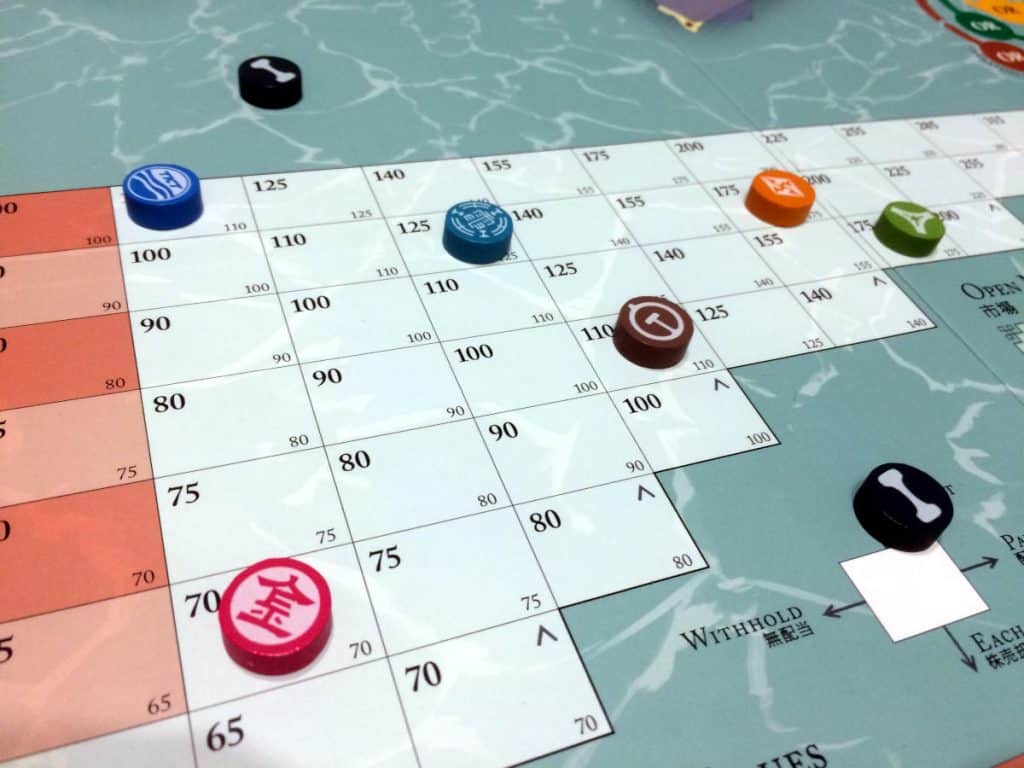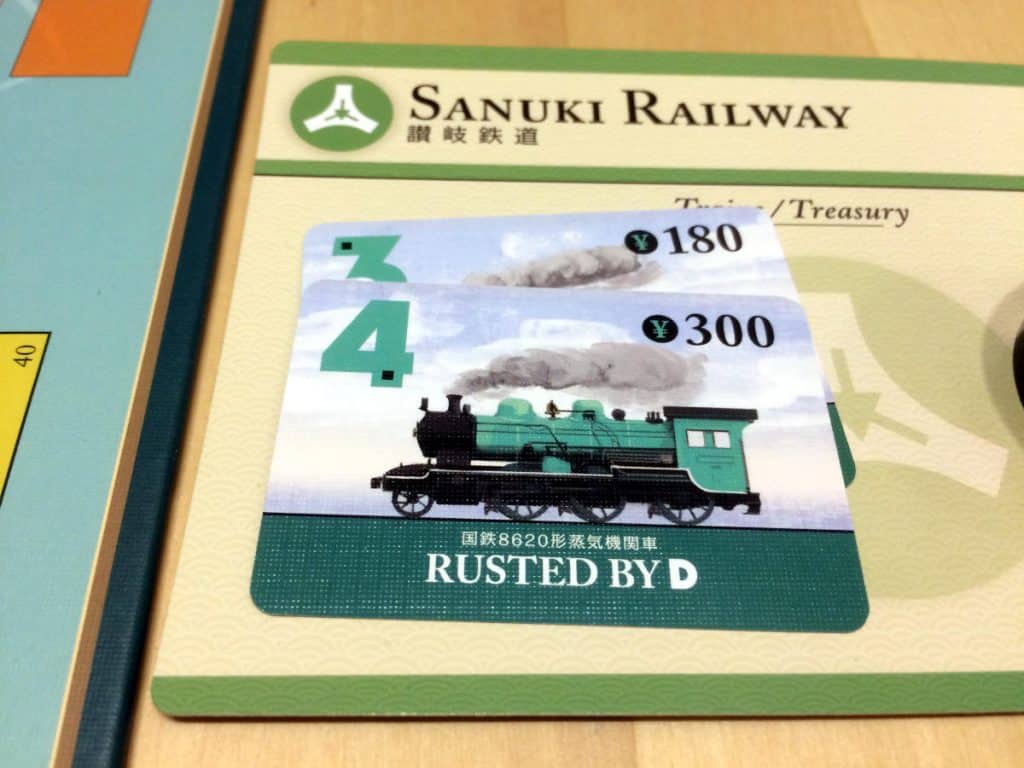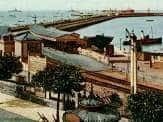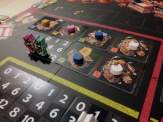| Release Date: 2023 | Players: 2-6 |
| Designer: Yasutaka Ikeda | Length: 150-240 minutes |
| Artist: Karim Chakroun | Age: 14+ |
| Publisher: Grand Trunk Games | Complexity: 3.5 / 5 |
| Plastic (by weight): <1% | Air (by volume): 15% |
The period of sakoku has only recently ended, and now with the Meiji Restoration in full swing, the country is investing heavily in new technologies. Locomotives have become the leading symbol of the nation’s modernization. Across all four islands, new railway operations are created and entrepreneurs attempt to profit from the money being injected into the economy. Our small island is no different. It’s the same here on Shikoku 1889 by Yasutaka Ikeda from Grand Trunk Games.
Listen to the Audio Version
Intro Music: Bomber (Sting) by Riot (https://www.
Music: JoDon by Blue Dot Sessions
18xx
I have been tracking the genre of 18xx games for a while now. I needed to gauge my game’s group interest first. It was important for me to be tender. So I decided to start them off with a cube rail game. Eventually, I felt safe to make the switch and I backed the crowdfunding campaign for the reprint of Shikoku 1889. However, even then it took a while to get the game to the table after it had arrived. Yet, in the end, it was all steam ahead and we were happily bidding on companies, buying shares and laying track. It was a long journey, but it was really worth it.
The term 18xx is used to describe railroad-themed economic simulation, tile-laying games. All games in the genre are very similar. They are all based on Francis Tresham‘s game 1829. So once you know the rules of one, you only really need to learn the differences to another game to be able to play it, which means that 18xx is like a game system. Generally speaking, 18xx games are heavy, complex games that take many hours to play. In reality though, that’s not completely true.
As someone who loves economic simulation games, whose inner child loves laying track and playing with trains, even if they are represented by simple hex tiles on a very functionally illustrated board, and who wanted to try games that are a little more complex and take longer to play, I knew I had to break into the genre of 18xx games. So when everyone I spoke to listed Shikoku 1889 as the best game to start with, I just had to back it when an overhauled version came to crowdfunding.

Choo-Choo
Now, contradictory to what everyone says, learning how to play Shikoku 1889 is actually not that difficult. The rulebook of the new edition is really good and has a lot of illustrations to help you along. For a little extra help, I strongly recommend you watch Ambie Valdés’ rules-teach video. As a very visual person, I found it really useful and it’s what I told my game group to watch before our first game.

Get yourself a wooden Tabletop Games Blog dice tray.
Each tray is the perfect size to roll your dice, and with the soft mat, it’s really quiet, while the wooden frame makes it wonderfully sturdy.
Shikoku 1889 is all about buying shares in train companies, building up the rail network, buying locomotives to run on the railway lines and paying out dividends or withholding them, while keeping an eye on the stock market value of the train companies. You keep switching between so-called stock rounds and operating rounds. There is a strict separation between your own money and the companies’ money. So while you might control the majority of shares in several companies and you can decide what each company does with its money, you can’t just withdraw it and add it to your own. You can’t even pay your personal money into a company’s coffers.
So, at the end of a game, if a company has a lot of cash available, it doesn’t help you win the game. It’s purely your personal cash and the stock value of the shares you own that decide who wins. In theory, you don’t even have to control any companies to win. As long as the person who controls the company keeps increasing its share price by paying out dividends, you will benefit and can potentially become the winner.
Hard to Master
The thing is, I’m not actually sure what the best strategy is to win Shikoku 1889. It’s the sort of game that is relatively easy to learn, but very hard to master. Some of it is certainly down to pure maths. If you can work out the potential profit of a company to decide when best to buy or sell shares, you should do well.
However, that’s not all. There is also a lot of indirect player interaction. If you can drive the value of a company up and attract investors, you are also able to dump all your shares just before the company is about to run into trouble and leave someone else in charge with no way out.
It also helps if you can set up your railway company so that it can benefit from the track that another company, ideally another player’s, has laid. If you can time it right, within one or two operating rounds, you could benefit from a giant network of tracks that connects your train line to many profitable destinations.
I was really surprised by how much subtlety there is to Shikoku 1889. I was expecting it to simply be about making the best purchase decisions and building the most profitable rail network. However, as the game progresses and the map slowly fills with tracks, things can quickly change and a tiny company that only started the previous round has access to all of the hard work from another company that suddenly sees fierce competition on its own network.
When you buy locomotives is also important, as they represent the timer in the game. As newer models become available, older ones become obsolete and end up on the scrap heap. Biding your time to be able to access locos that are able to travel further can turn out to be hugely profitable.

Shares and Locomotives.
It really feels like Shikoku 1889, like many other 18xx games, is all about timing. You have to buy and sell shares at the right time, buy locomotives at the right time and lay the right track at the right time. You also have to be prepared to play the game for a few hours. However, I always felt that time went really quickly, probably because I love these types of games so much. Saying that, 18xx games are the sort of games where it is all right to stop early and agree on a winner. There will come a time when it’s obvious that it’s impossible to catch up with the leader. That’s absolutely fine and doesn’t make the game any less enjoyable. It just is how it is.
I know I haven’t really explained how 18xx games work, because there is a lot to them. However, I can say that I love these games and can’t wait to try another game in the genre. The mix of the stock market and track laying always gets me very excited. It takes me back to my childhood when playing with a toy train set and playing stock market games were two of my favourite family activities. So maybe it’s nostalgia, but given the popularity of games like Shikoku 1889, I don’t think it’s just that.
So if you like economic simulation games, but have never been brave enough to give 18xx a go, then I strongly recommend you check out Shikoku 1889. I can assure you that it’s the best way to make your first tentative steps into the genre – and it’s definitely not as hard as it may sometimes seem.
This blog is free for everyone, but if you'd like to support it, here are some options.
Useful Links
- Shikoku 1889: https://www.
grandtrunkgames. com/ - Rulebook: https://boardgamegeek.
com/ filepage/ 267620/ shikoku-1889-rulebook-compressed - Rules video: https://youtu.
be/ UHnAIDAzOpk? feature= shared - Grand Trunk Games: https://www.
grandtrunkgames. com/ - BGG listing: https://boardgamegeek.
com/ boardgame/ 23540/ shikoku-1889
Videos
Transparency Facts
I feel that this review reflects my own, independent and honest opinion, but the facts below allow you to decide whether you think that I was influenced in any way. Please also read my Ethics Statement for more information.- I bought and paid for the game myself.
- At the time of writing, I have not received financial support from the publisher or anyone working on their behalf.
Audio Version
Intro Music: Bomber (Sting) by Riot (https://www.
Music: JoDon by Blue Dot Sessions
Playlist
These are the songs I listened to while I was writing this review:





